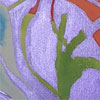Our History and Mission
The Society for the Arts in Dementia Care: In the beginning …
 The
idea for the Society for the Arts in Dementia Care originated in Canada
in 2004. It grew out of the experience of Dalia Gottlieb-Tanaka, who had
developed a program of Creative Expression Activities in her work with
seniors living with dementia. As a PhD student at the University of
British Columbia's Institute of Health Promotion Research, an
Interdisciplinary Program, she was inspired to engage a wider audience
of professionals and practitioners in exchanging ideas and strategies to
address the needs of this population of seniors when engaged in the
creative arts. Early on, she arranged a successful exhibition of artwork
produced by the seniors she worked with; it took place at the Ferry
Building Gallery in West Vancouver, BC, in 2003. More than 4,000 people
visited the gallery over three weeks. The exhibition included seminars
and workshops free of charge and was attended by healthcare providers,
caregivers, seniors living with dementia and the community at large.
The
idea for the Society for the Arts in Dementia Care originated in Canada
in 2004. It grew out of the experience of Dalia Gottlieb-Tanaka, who had
developed a program of Creative Expression Activities in her work with
seniors living with dementia. As a PhD student at the University of
British Columbia's Institute of Health Promotion Research, an
Interdisciplinary Program, she was inspired to engage a wider audience
of professionals and practitioners in exchanging ideas and strategies to
address the needs of this population of seniors when engaged in the
creative arts. Early on, she arranged a successful exhibition of artwork
produced by the seniors she worked with; it took place at the Ferry
Building Gallery in West Vancouver, BC, in 2003. More than 4,000 people
visited the gallery over three weeks. The exhibition included seminars
and workshops free of charge and was attended by healthcare providers,
caregivers, seniors living with dementia and the community at large.
This event demonstrated that there was wide interest in the seniors' condition and curiosity about what kind of creative work the seniors could do. The exhibition and related events served as a catalyst for conferences that Dalia organized at UBC in 2005 and 2006. The Conferences on Creative Expression, Communication and Dementia (CECD) introduced a new concept and new forum where anyone with an interest in dementia care and creative activities could come together to exchange ideas: academics, medical experts, researchers and caregivers responded enthusiastically. About 155 participants attended each conference from across Canada, the US, the UK and Australia.
As the original sponsor for the CECD conferences, the Society for the Arts in Dementia Care considers conferences to be an educational tool, along with workshops, lectures and hands-on demonstrations that offer help in improving the quality of life for seniors with dementia.
In 2006 Hilary Lee of Perth, Australia, attended the CECD conference, making a presentation on her tapestry project. Hilary immediately recognized the Society's value and volunteered to join forces with us, adopt the concept and set up a branch. Shortly thereafter, the Society for the Arts in Dementia Care (Australia) was born.
Since then, professional who attended these conferences have replicated the experience in their own communities, bringing new ideas and the opportunity to share common experiences to many others who care for these seniors. We welcome these initiatives and applaud the positive effect they can have on the seniors' quality of life.
Reasons for establishing the Society: Facts in Canada
 The
aging population in Canada will peak between 2025 to 2045 when the
Baby Boom generation reaches 75+ years of age (Health Canada, March,
2001). There will be significant pressure on the healthcare system
and on support services for older people. Long-term care facilities
will experience higher demand for their services. According to
Health Canada, one of every four people over the age of 80 will have
some form of cognitive impairment. These pressures may threaten the
quality of services for seniors with dementia in the future.
The
aging population in Canada will peak between 2025 to 2045 when the
Baby Boom generation reaches 75+ years of age (Health Canada, March,
2001). There will be significant pressure on the healthcare system
and on support services for older people. Long-term care facilities
will experience higher demand for their services. According to
Health Canada, one of every four people over the age of 80 will have
some form of cognitive impairment. These pressures may threaten the
quality of services for seniors with dementia in the future.
Today, most services are geared to meeting basic needs, while existing quality of life programs, such as those based on creative self-expression, have never really reached their potential. The consensus among researchers is that creativity enhances the quality of life at every stage in human development from cradle to grave and that the idea of everyday creativity manifests itself in being curious, in an ongoing process of self-evaluation and personal growth. If we accept the premise that creativity improves psychological health and contributes to the empowerment process, the ultimate goal is to enable persons
living with dementia to maintain and enhance the quality of their lives and to use their remaining abilities to express themselves.
The Society's Mission
 The Society for the Arts in
Dementia Care is built on the premise
that older adults and people living with dementia have the right to dignity, to be heard and to be valued.
The Society provides an interdisciplinary forum for creative expression with older adults by bringing together academic research and practical knowledge.
The Society aims to disseminate knowledge and establish links with organizations with similar values worldwide, thereby improving the quality of life of older adults, especially
those living with dementia.
The Society for the Arts in
Dementia Care is built on the premise
that older adults and people living with dementia have the right to dignity, to be heard and to be valued.
The Society provides an interdisciplinary forum for creative expression with older adults by bringing together academic research and practical knowledge.
The Society aims to disseminate knowledge and establish links with organizations with similar values worldwide, thereby improving the quality of life of older adults, especially
those living with dementia.
The Society’s Role
 The Society for the Arts in Dementia Care was conceived as an umbrella organization that could bring together academics and practitioners to discuss topics of mutual interest and make the arts a recognized partner in dementia care. Presently, there is no known cure for this condition and it is clear that the medical model of dementia care needs to be reinforced with approaches that promote social and creative well-being.
The Society for the Arts in Dementia Care was conceived as an umbrella organization that could bring together academics and practitioners to discuss topics of mutual interest and make the arts a recognized partner in dementia care. Presently, there is no known cure for this condition and it is clear that the medical model of dementia care needs to be reinforced with approaches that promote social and creative well-being.
Creative expression facilitators and practitioners in art
therapy, music therapy, occupational therapy, dance therapy,
reminiscing therapy, storytelling and drama therapy need to work
closely with the medical and scientific community to fully
understand the seniors' needs and potential. This alliance is
crucial in achieving appropriate creative expression programs
and activities. And, knowing the vulnerability of older people,
we ask: How can we adjust creative expression activities to
accommodate specific physical needs or abilities? Policy makers,
administrators of care facilities and the community at large
need to be ready to provide funding for the services this
growing population requires. The Society's role is to provide
the forum where these discussions can take place.
The Society and its affiliates share these aims:
- To advocate for and support older adults and people living with dementia
- To provide an interdisciplinary forum where all of us can meet to share recent findings and practical experiences, and collaborate on innovative approaches
- To better understand dementia and how to cope with this condition using creativity
- To increase awareness among artists, caregivers and political leaders of the importance of creative expression activities in health care
- To encourage artists to seek opportunities in therapeutic services and by doing so, enrich the pool of creative expression programs in dementia care
- To develop standards and designs for the therapeutic environment that improve the seniors' quality of life
